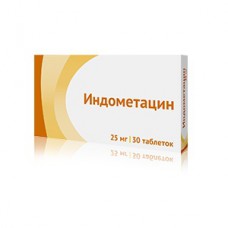Expiration date: 03/2025
Composition
1 tablet contains: indomethacin - 25, 0 mg
Pharmacotherapeutic group
Nonsteroidal anti-inflammatory drug (NSAID)
Pharmacological action
Indomethacin has anti-inflammatory, analgesic, antipyretic and anti-aggregating action. Suppresses the activity of proinflammatory factors reduces platelet aggregation. Inhibiting cyclooxygenase I and II , violates the metabolism of arachidonic acid, reduces the amount of prostaglandins (Pg) as in inflammation, and in healthy tissues, inhibits exudative and proliferative phases of inflammation. Eliminates or reduces pain syndrome and rheumatic rheumatic nature (including when joint pain at rest and in motion, decrease morning stiffness and swelling of the joints, helps to increase range
movements in inflammatory processes arising after operations and traumas, quickly relieves both spontaneous pain and pain at movement, reduces inflammatory edema in the wound).
Indications for use
Acute and chronic pain in inflammatory diseases of the musculoskeletal system: rheumatoid arthritis, juvenile chronic arthritis, chronic ankylosing spondylitis (Bechterew's disease), gouty arthritis, psoriatic arthritis, Reiter's disease, diseases of the periarticular tissue: tendinitis, bursitis, andobesity, tendovaginitis, injuries in athletes, slipped disc, neuritis, plexitis, radiculoneuritis. The medicine is intended for symptomatic therapy, reducing pain and the inflammation at the time of use, on disease progression is not affected.
Contraindications
Hypersensitivity to indomethacin or any of the excipients of the drug, anamnestic data about the attack of bronchial mast, rhinitis, urticaria after taking acetylsalicylic acid or other NSAIDs (complete or partial syndrome of intolerances acetylsalicylic acid – rhinosinusitis, urticaria, polyps are nasal mucosa, bronchial asthma), erosive-ulcerative changes of the gastric mucosa or 12 duodenal ulcer, active gastrointestinal bleeding, inflammatory bowel disease (ulcerative colitis, Crohn's disease), congenital heart disease (severe coarctation of the aorta, pulmonary artery atresia, severe tetralogy of Fallot), period after coronary artery bypass surgery, decompensated heart failure, renal failure (creatinine clearance (CC) less than 30 ml/min), progressive kidney disease,
hepatic insufficiency or active liver disease, disorders of blood coagulation (including hemophilia, prolonged bleeding time, bleeding tendency), a violation of hematopoiesis (leukopenia and anemia), confirmed hyperkalemia, hereditary lactose intolerance, lactase deficiency and glucose-galactose malabsorption, pregnancy and breastfeeding, children's age (up to 14 years).
Method of application and doses
Inside, after eating, squeezed enough water. Adults and children over 14 years: starting dose is 25 mg 2-3 times a day. With insufficient therapeutic effect dose increase to 50 mg 3 times a day. The maximum daily dose is 200 mg. With prolonged treatment, the daily dose should not exceed 75 mg.
Gouty arthritis: for relief of acute gouty attack initial dosage is 100 mg, then continue treatment at 50 mg 3 times a day until the pain disappears. Side effects can be reduced by using the minimum effective dose for the shortest possible period of time.
Form release
Tablets, enteric coated tablets 25 mg 30 tablets per pack.


